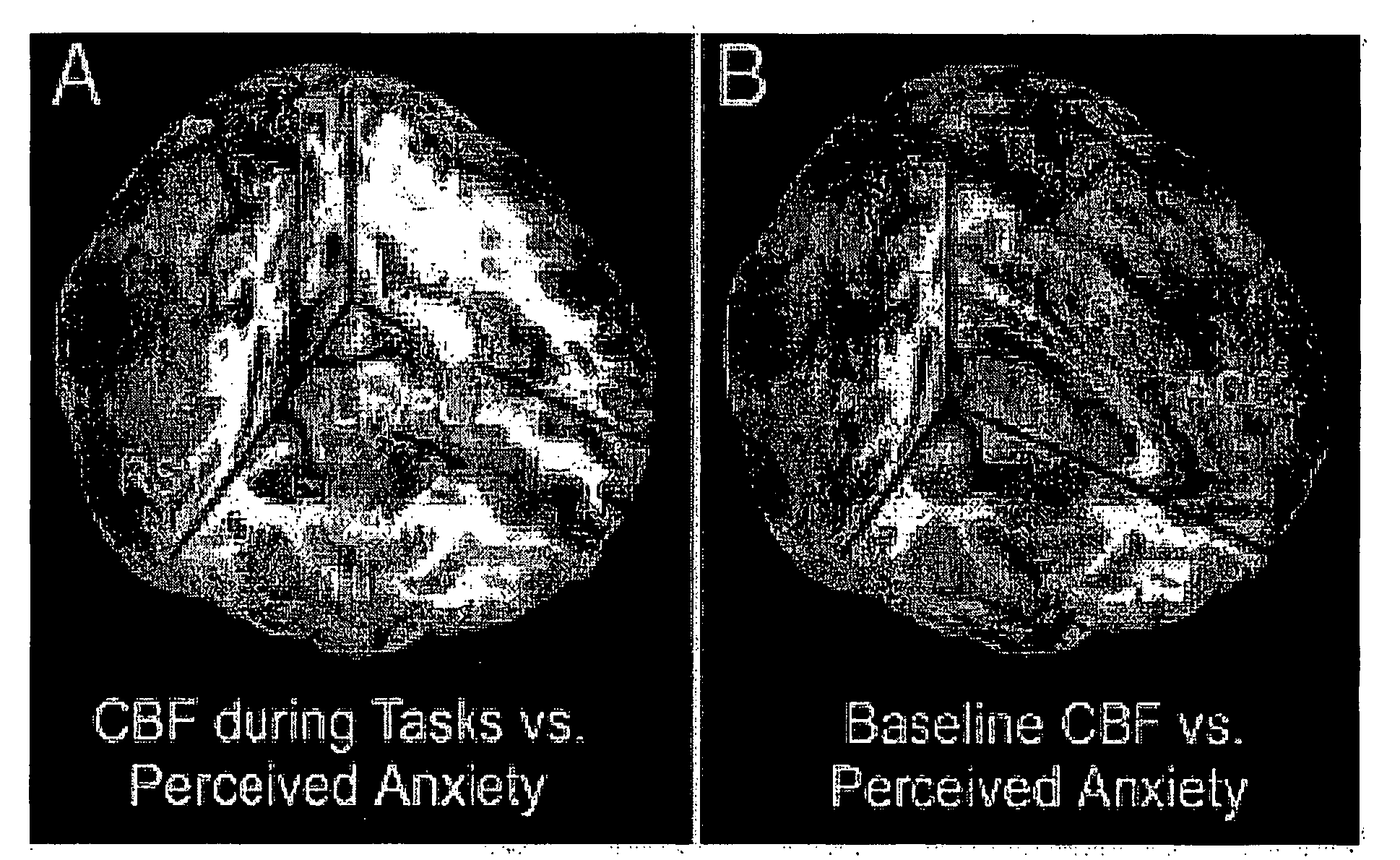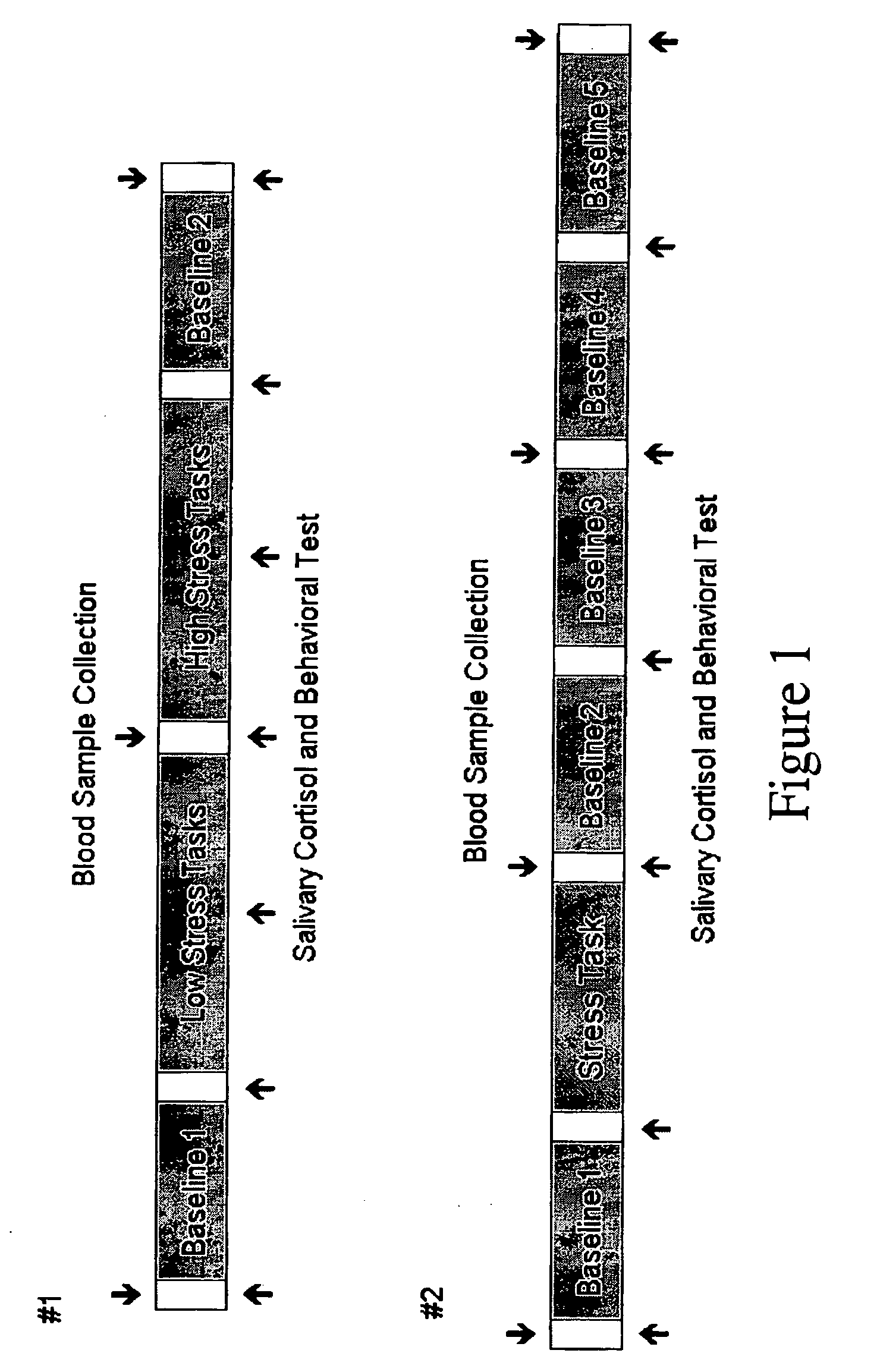Assessing subject's reactivity to psychological stress using fmri
a psychological stress and subject technology, applied in the field of assessing subject's reactivity to psychological stress using fmri, can solve the problems of no exclusive testing procedures, unable to establish causal relationship between particular personality dimensions/factors and stress reactivity, and candidates may conceal their character
- Summary
- Abstract
- Description
- Claims
- Application Information
AI Technical Summary
Benefits of technology
Problems solved by technology
Method used
Image
Examples
example 1
Perfusion Functional MRI Reveals Cerebral Blood Flow Pattern Under Psychological Stress
Results
Behavioral and Physiological Data
[0076]The results of subjects' self-ratings of stress, emotion, and physiological responses suggest that the stress-elicitation paradigm successfully induced a mild-to moderate level of psychological stress. Average self-report of stress (P=0.002) and anxiety (P=0.008) levels and the heart rate (P<0.001) increased from the low-stress task to the high-stress task and decreased during the second baseline period (see FIG. 2). Salivary cortisol, a stress-related hormone, reached its peak 10 min after the end of the high-stress task (P=0.045), consistent with the expected time lag between peripheral cortisol and behavioral measures. Subjects' ratings of task difficulty (P<0.001), effort required (P<0.001), and frustration (P<0.001) were significantly elevated in the high-stress condition relative to the low-stress condition (see Table 1). In addition, we found th...
example 2
Gender Difference in Stress Response Revealed by Perfusion MRI
Methods
[0082]Thirty-two healthy subjects (16 females and 16 males) were included in this study. The mean ages of the female and male group were 22.8±2.4 (SD) and 24.3±3.1 years (n.s.). The protocol consisted of 4 8-min perfusion fMRI scans: one low stress task (counting backward), one high stress task (serial subtraction of 13 under pressure), and two baseline scans before and after stress tasks. Self report of stress and anxiety level (1-9), heart rate (HR) as well as saliva samples were collected during the experiment (2). Perfusion fMRI data were analyzed using VoxBo and SPM2. After motion correction and spatial smoothing, label and control images were pair-wisely subtracted and converted to absolute perfusion image series. Voxel-wise analyses of the perfusion data were first conducted in each subject. Two contrasts were defined i.e., the perfusion difference during stress tasks (high−low stress) and the perfusion chan...
example 3
Neural Pathways Associated with Salivary Cortisol in Men and Women
[0088]The above results were based on regression of brain responses with subjective stress experience, which may differ between men and women. For instance, it has been reported that females may have a lower threshold for perceived stress compared to males since puberty. We therefore performed a third regression analysis to detect associations between baseline CBF variations (Baseline 2−1) and AUC measures of salivary cortisol—a physiological index of overall stress elevation caused by undergoing the experimental stress paradigm. Again, in the male subjects, we found that baseline CBF increase in the RPFC and CBF reduction in the LOrF / IFC were correlated with AUC measures of salivary cortisol (FIGS. 13C&14C). In contrast, significant cortisol related CBF increases were observed in the dorsal ACC (dACC) and left thalamus (LTh) only in the female but not the male group (FIGS. 13C&15C). Females also showed cortisol relat...
PUM
 Login to View More
Login to View More Abstract
Description
Claims
Application Information
 Login to View More
Login to View More - R&D
- Intellectual Property
- Life Sciences
- Materials
- Tech Scout
- Unparalleled Data Quality
- Higher Quality Content
- 60% Fewer Hallucinations
Browse by: Latest US Patents, China's latest patents, Technical Efficacy Thesaurus, Application Domain, Technology Topic, Popular Technical Reports.
© 2025 PatSnap. All rights reserved.Legal|Privacy policy|Modern Slavery Act Transparency Statement|Sitemap|About US| Contact US: help@patsnap.com



